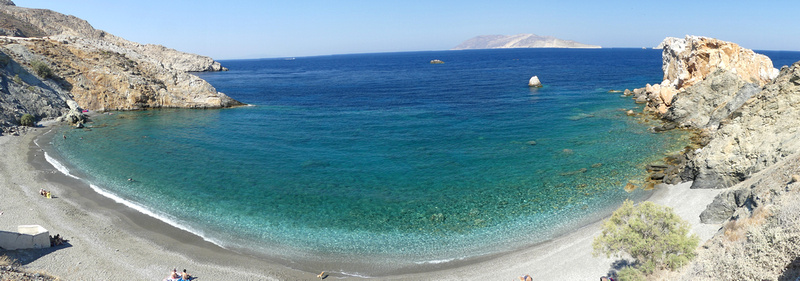


Summer 2019 Part 4 - Lyon and Dijon France
After three weeks in Italy and Croatia with my husband, we flew (EasyJet, 47€ each) to France. Although I've been to France many times I've never visited it's second (Marseille) and 3rd (Lyon) largest cities. My husband is not a fan of large cities, nor for some reason, of France, so I sent him home and spent 3 days in Lyon, 6 in Marseille and then 2 in Dijon (and spending the last night in Paris before flying back to the US). My husband had one day before his flight so we did a day trip to the medieval town of Perouges, and I did a half day trip to town of Vienne.
LYON
With a population of 500,000 Lyon is the 3rd largest city in France. It’s a UNESCO world heritage site for its old town, Vieux Lyon, and it’s traboules. Lyon has a nice setting at the confluence of the Rhone and Saone Rivers. The large island between them, Presque’ile, has several squares linked by pedestrian streets with a vaguely ‘Parisian’ like look. Unfortunately most were in the process of being re-paved and everything was torn up with construction equipment and a lot of jack hammering going on. Even without that, the comparison with Paris would be marginal. But the view of old Lyon across the Saone River is lovely.
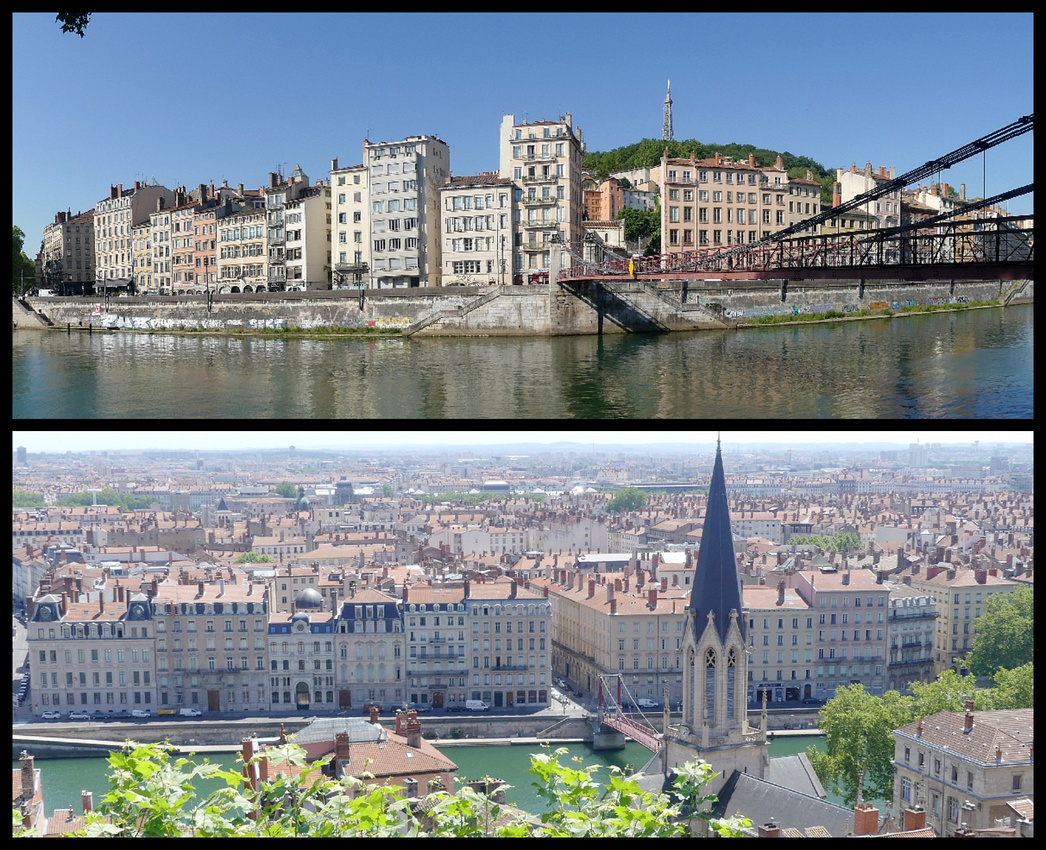

Vieux Lyon - Reached by one of the three passerelles (footbridges) crossing the Saône from the Presqu’île, Vieux Lyon is made up of what was once three villages - churches and the ‘neighborhood’ around each (now all blend together) - St-Jean, St-Georges and St-Paul, at the base of the hill of Fourvière. Cobbled, pedestrianized streets lined with Renaissance and medieval facades really does have ‘Old World’ ambience. Place Neuve Saint-Jean, is the main square. The cathedral’s main façade lacks most of its statuary as a result of various wars but is still impressive and the 13th Century stained glass and rose window are in perfect condition. The most interesting thing is the 14th Century astronomical clock, capable of computing moveable feast days (such as Easter) till the year 2019.




Lyon is considered by some to be the gastronomic capital of France. Throughout the city, but especially in Vieux Lyon are bouchons. A bouchon is a type of restaurant that serves traditional Lyonnaise cuisine.The forbearers of these bouchons were the taverns or inns where silk merchants stopped in the 17th and 18th centuries to have a meal, clean their horses, and, perhaps, rest overnight. They derived their name because the term bouchon was used then to describe the twisted straw brushes used to clean the horses. Each of these restaurants typically served only one main plate, such as roast pork, cheese with herbs, sausages, or duck pate. Today there are no longer any horses around but these eateries have menus that offer many of the same traditional dishes, usually several choices.
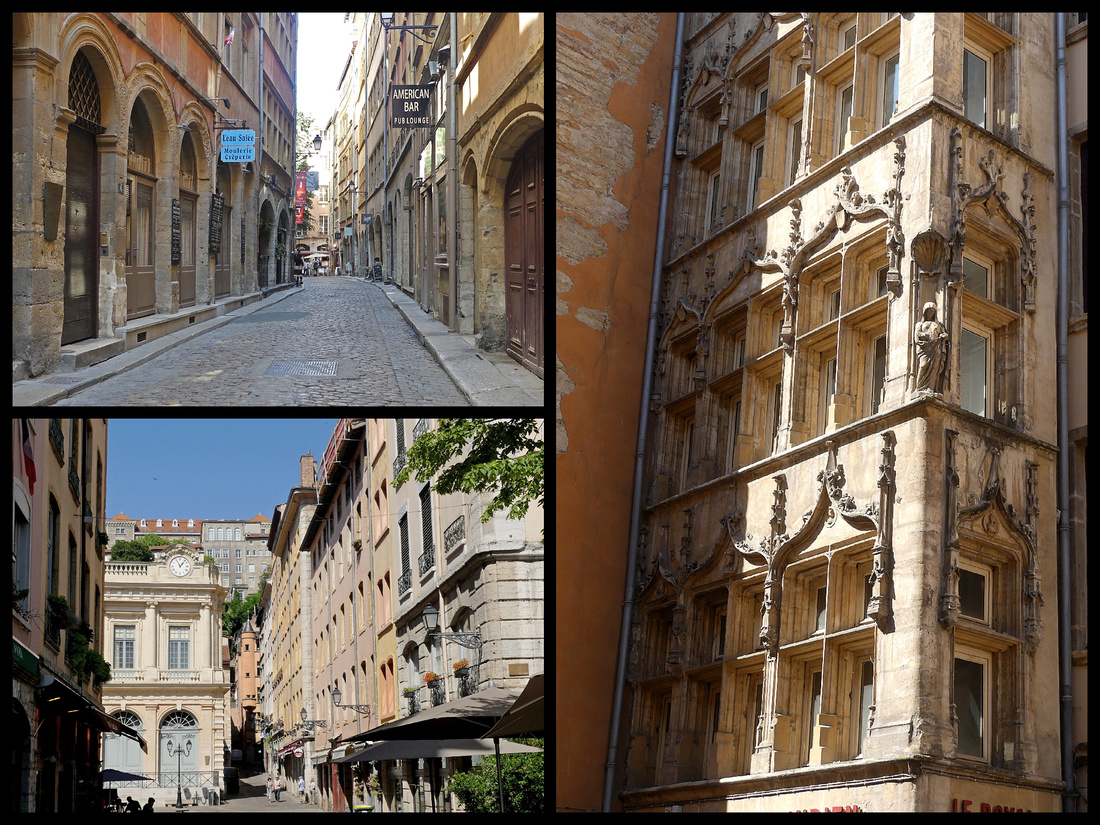



Traboules – The highlight of Lyon for me was the traboules – they are essentially shortcuts linking streets, which provided shelter from rain when reams of silk — a key industry in historic Lyon — were moved from one place to the next. Many are various shades of pastel colors, with medieval stonework, arches, loggias, spiral stone staircases. Other cities have them but Lyon has the most, and many are open to the public even though they are the entrances to private apartments. Most of those are marked with the bronze plaque that indicates anything in Lyon of historic interest, but not all. I had googled the addresses and the ones I found were all indeed open to the public as long as you were brave enough to push open a door that looked like a private entrance, and then push the light button. 6 Rue Trois Maries (actually enter from other side), 3 Place St Paul, 54 rue St jean, 28 rue St Jean. While tourist maps have locations and many tour groups visit them, most had very few people in them when I was there, you are expected to be quiet and respectful for the sake of the people who actually live there. They are so ‘hidden’ that they were used by the French resistance during WWll.


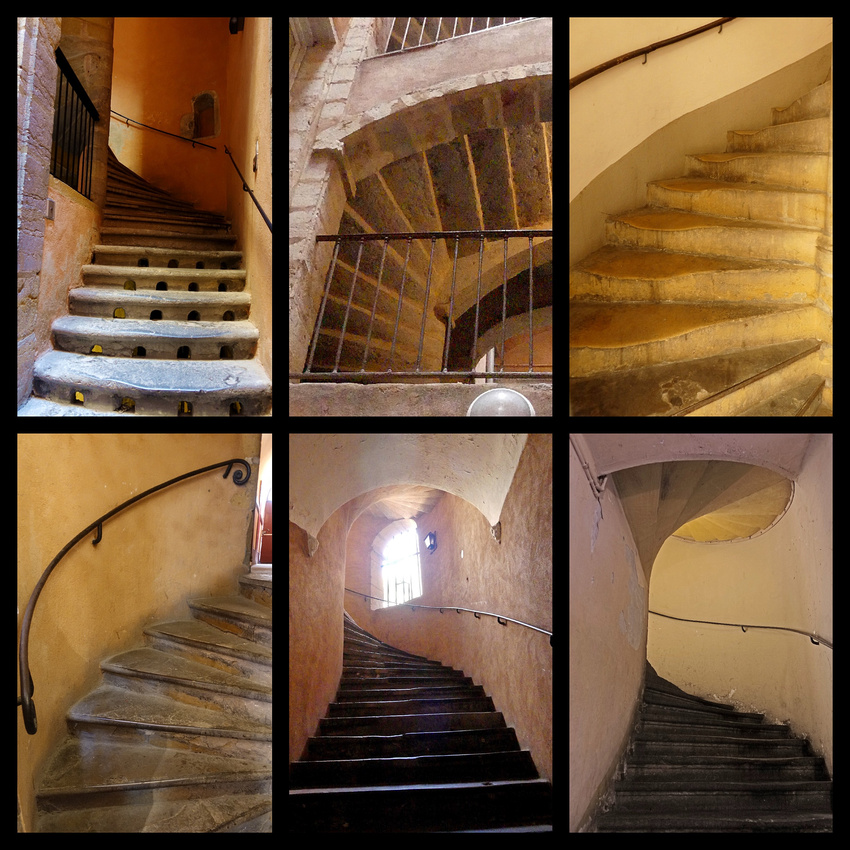



The other highlights of Lyon are up on Fouviere Hill. Reached by a funicular (same ticket as the metro) – or a steep walk up streets or stairs – at the top is a hulking, ornate wedding cake of a church, the Basilique Notre-Dame de Fourvière which was built, like the Sacré-Coeur in Paris, in the aftermath of the 1871 Commune to emphasize the defeat of the godless socialists. And like the Sacré-Coeur, its hilltop position has become a defining element in the city’s skyline. The interior has marble statues, stained glass and gold and turquoise mosaic wall panels. The crypt has some nice stonework and an ornate turquoise mosaic ceiling in the apse.
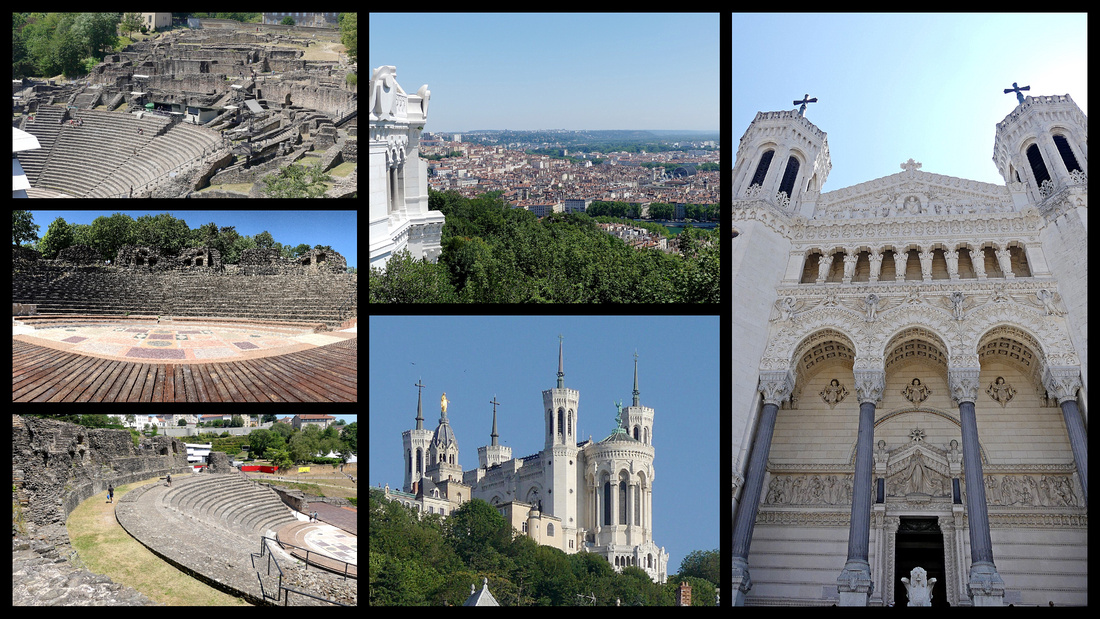

Halfway down the hill is Musée Gallo-Romain. Alongside the museum, dug into the hillside, are the substantial remains of two ruined theatres – the larger of which was built by Augustus in 15 BC and extended in the second century by Hadrian to seat 10,000 spectators. The theaters are free to enter and you can walk all around and in them (except for the section with the staging, as in almost every Roman theater in Europe these days, the centers are filled with staging for performances during the summer).
Fresque des Lyonnais (Mural of Lyon)- is a building mural covering the back and side of a bright yellow building on the bank of the Saône, just across a foot bridge from Vieux Lyon. It consists of 24 historic and six contemporary figures, with the modern-day characters painted at street-level to represent them interacting amongst today’s residents and visitors.
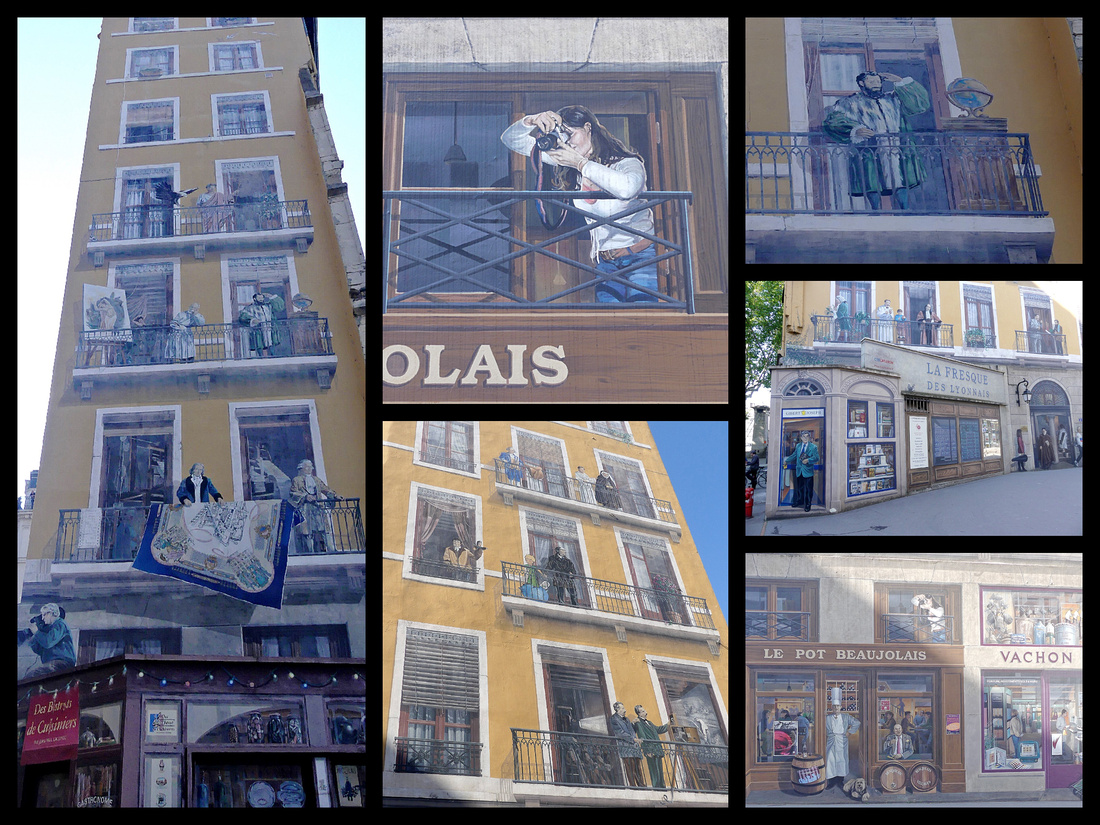

Presque'ile is the center of Lyon, a peninsula between the Rhone and Saone rivers. While Vieux Lyon feels medieval, Presque'ile feels like a mini Paris. There are a string of impressive squares, the central and largest of which is Place Bellecour. (The third section of Lyon, 'Part-Dieu', is the modern business section, home to the main rail station).


At the tip of Presqe'ile, is the Musee Conflulences, one of the best anthropology museums I've seen. It's not huge, the permanent exhibit is on the top floor and consists of five large rooms: The Origin of the species and our world (big bang theory and evolution), Species (who we are and what is our place in the world), definition of human identity and the link between humanity and animality (Some wonderful taxidermy animals); Societies (how we organize, exchange and create everything); an Eternities (visions of the beyond and how humans view/treat the passing between two worlds (death). A wonderful look at most aspects of physical and cultural anthropology. Everything is in English as well as French. The building the museum is housed in(built in 2014) is spectacular as well - looks like a space ship.
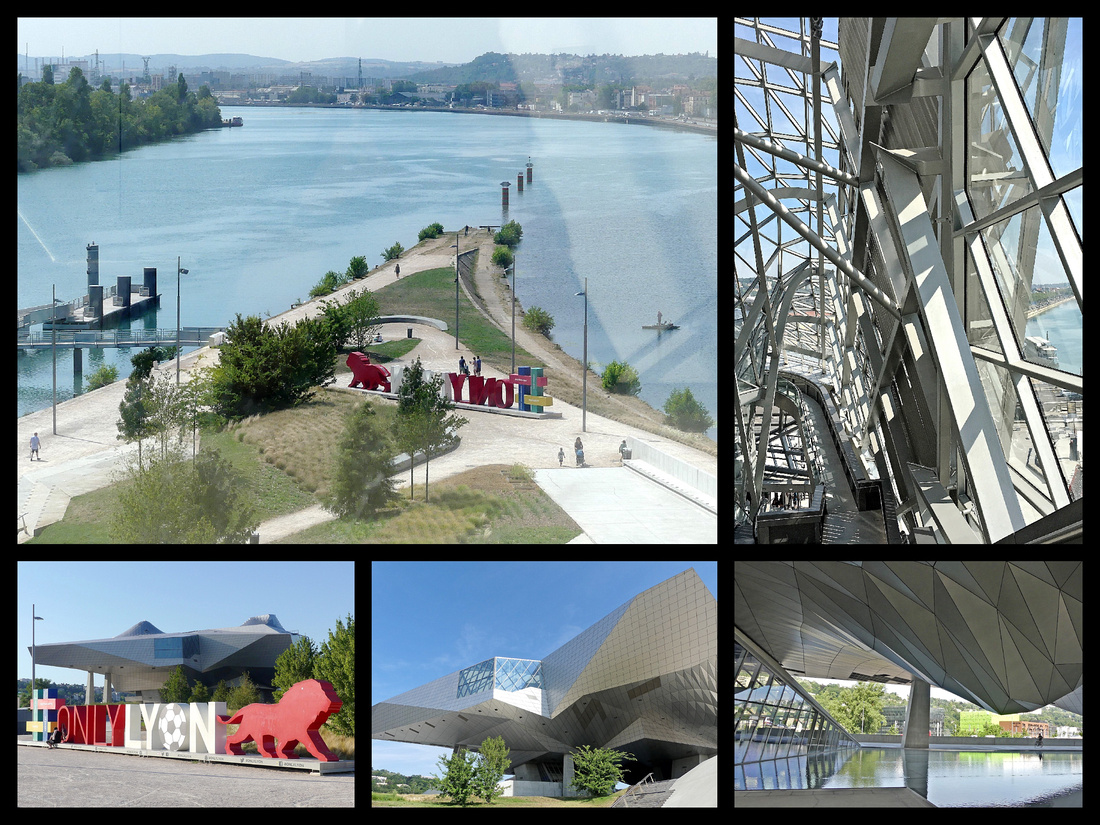

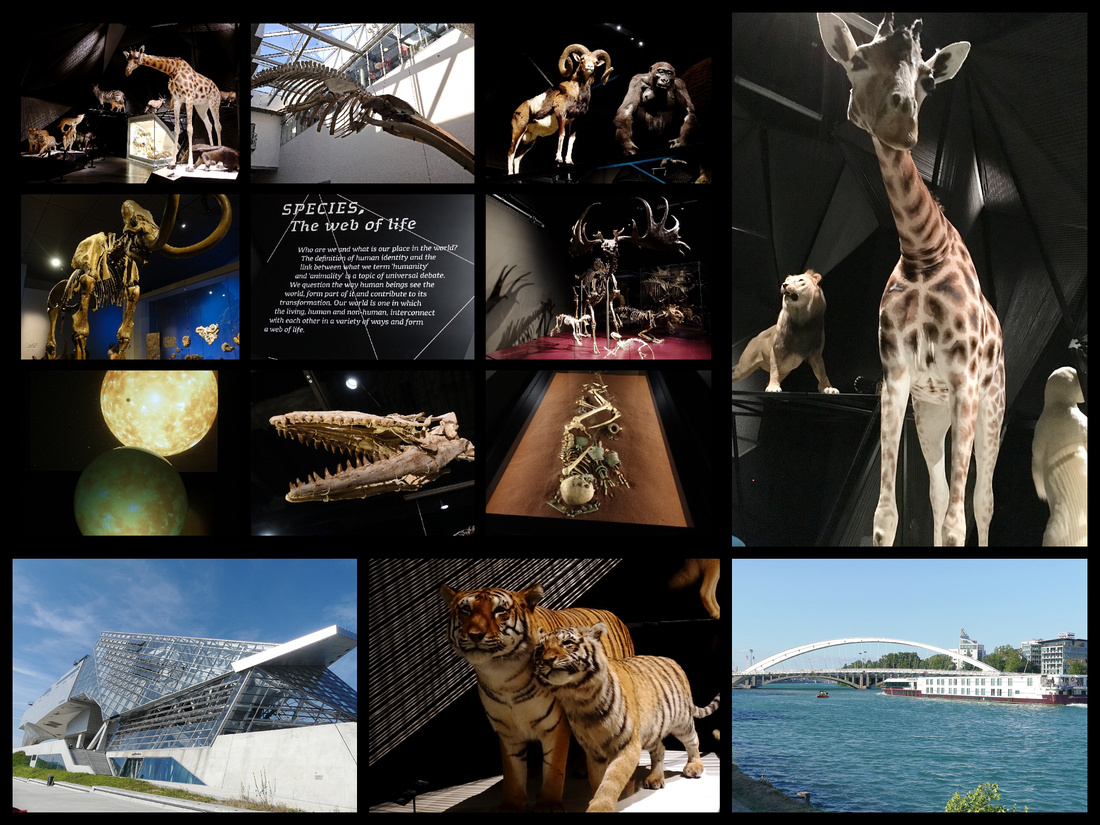

Reading opinions on travel forums and blogs, Lyon is frequently dismissed as 'not worth it', or 'boring'. While I'm glad I visited, and really enjoyed Vieux Lyon (and Musee Confluences), I have to admit it's not at the top of my list of favorite places in France. I think part of this is due to the fact the Presque'ile was undergoing major construction so many of it's streets and squares (and tram Line 1) were all torn up and not at all pretty or enjoyable. I felt three days was adequate and I don't have the urge to go back (unlike almost everywhere else in France).
After three weeks of staying in B&B's and small apartments, in Lyon we stayed in a convenient and comfortable, but soulless, chain hotel - Quality Suites Lyon Confluence. I chose it because of it's location near Perrache train station (arriving and departing ease and day trips) and right on Tram Line 1 (which was not in use due to construction, so that didn't work out). Booking.com, 88€ night/double.
PEROUGES
An easy enough day excursion by train from Lyon Part-Dieu train station to Meximieux Pérouges station, 30 minute walk from old town, flat except for the last 10 minutes up the hill. There are trains every 2 hours or so. The station there looks to have been shut for years but has kiosks to buy tickets, though given how well they work it’s best to get return tickets before leaving Lyon. About €8 per person each way, takes about ½ hour. We ended up getting the 10:12-10:45 there and the 16:16-16:48 back. No signs at the station as to where the town is but turn left and eventually you see signs for “Medieval Perouges”.
As we were walking towards the old town a French couple must have thought we looked lost because they started to tell us which way to go and began walking with us. When we said we didn’t speak French he said “London?” and I said ‘no, United States’, he really lit up, pointed to his hat (which said “Seals”) and said he was a French GI. Then he made some remark about Trump, (and my husband replied, in French, that Trump was a pig) which this guy thought was hysterical. This man and his wife (who smiled a lot but never said anything) kept walking with us for several minutes, chattering nonstop, most of which we didn’t understand (he did say Bill Clinton had been there). Anyway, they seemed to really like Americans, shook our hands as they were turning down a different street, wished us a good trip.
Pérouges is a village on a small hill of cobbled alleyways and ancient stone houses, an immaculate work of conservation (including all utilities buried) that really makes you feel like you stepped back into medieval times. Its charm has not gone unnoticed by the film industry (The Three Musketeers, 1961 and several others were filmed there).


The streets and the buildings are all kind of a light grey/honey color stone. There are two gated entrances “Porte d’en Bas” (bottom door) and “Porte d’en Haut” (upper door) and a street that encircles the village, a couple of alleys and a main square, La Place de la Halle. The main square is the site of a majestic linden tree planted during the French Revolution, 1792. Because of this, the plaza is also known as the liberty tree – La Place du Tilleul. Some buildings in the village are clearly not in use but everything is very well cared for. A few tourist shops but nothing tacky. A few restaurants, no fast food. One museum/tower (€5 entry) with so-so views (it’s not very high) and a nice medieval interior (several huge fire places), some weaving paraphernalia, various old objects.
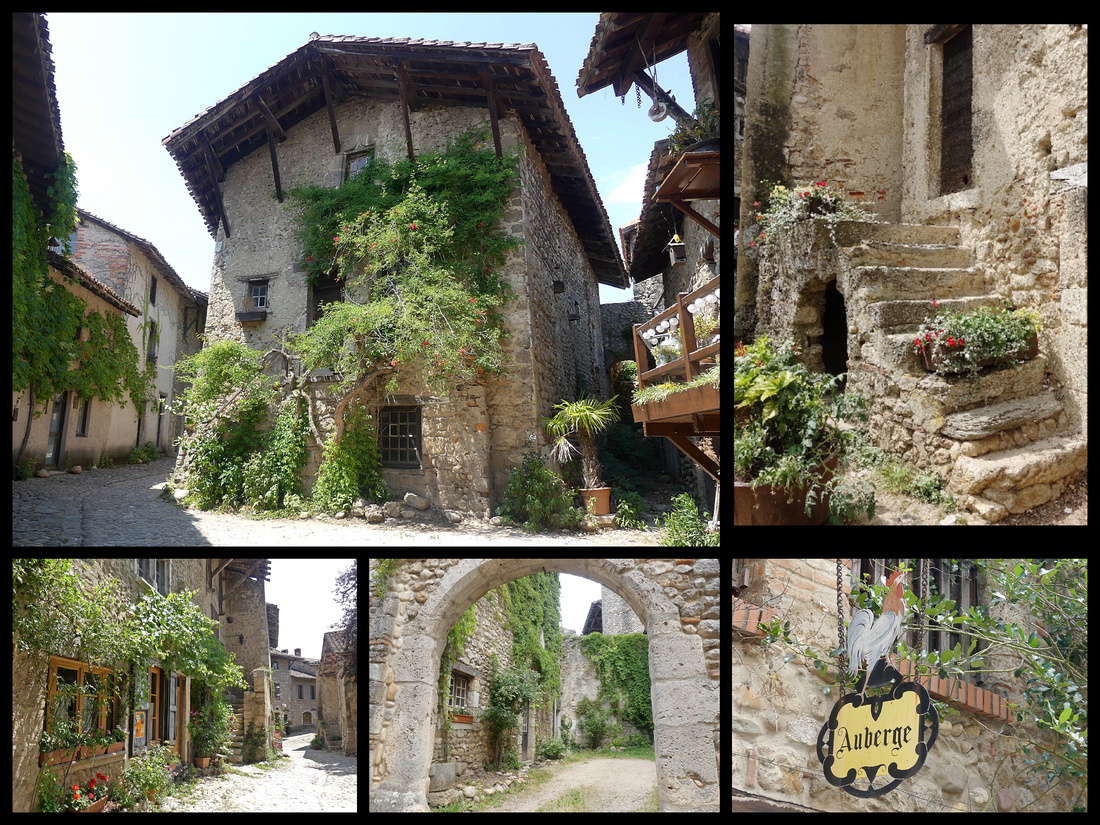

The town was originally founded in the 1100’s by a Gallic colony returning from Perugia, Italy resulting in the French name of “Pérouges.” By the 14th and 15th centuries, the town was inhabited by craftsmen, primarily wine-makers, linen weavers, and farmers. It was on the road between Lyon and Geneva. By the end of the 18th century, there were nearly 1,500 residents. The textile industry came to a halt in the 19th century when railroads bypassed the town, resulting in a precipitous population drop to just 90 people. This is also the reason modern building or renovations never occurred.


We ate lunch at 'Relais de la Tour' on the main square. The price fixed lunch included a ‘buffet’ of charcuterie and crudités, main dish of ham and mashed potatoes in a mushroom cream sauce or chicken and green beans, and a dessert buffet (dark chocolate mouse, Chantilly, ice cream, tarts). My huband got a “Pression medieval” (medieval beer). Total €37. Very breezy but nice in the sun and the setting was gorgeous.
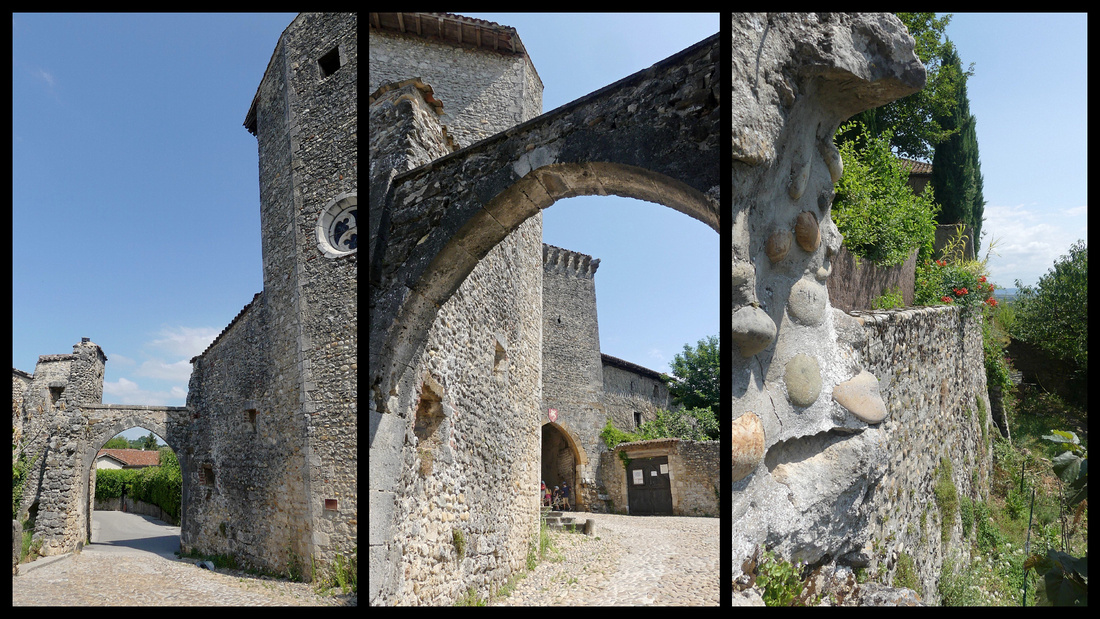



We were there 10:45-16:16 so 5 ½ hours but at least an hour of that was the walk up and back. You really ‘need’ about 3 hours to see the village (we walked around it 3 times) and have an hour-long lunch. There were a few other tourists around, but no crowds at all. As we were leaving we wondered why tour groups didn’t invade this place, it’s so picturesque. Then we saw two, Viking River Cruise tour buses heading in as we were walking back to the train.
VIENNE is another very easy day trip from Lyon (train stops in both Part-Dieux and Perrache stations in Lyon), ½ hour to Vienne, €7, two or three trains per hour. The gare in Vienne is a short walk from the sites. Vienne is known for its abundance of Roman ruins, many of which are just fragments but there are a lot of them, scattered about the city and able to be seen for free. The most exceptional is the Temple of August and Livia, on Place du Palais (site of the Roman forum), 1st Century BC, completely intact just sitting there like any other building. Along with the Maison Carrée in Nîmes, it is one of the two best examples of a Roman edifice of this kind in France. It was well preserved because the temple became a church around the 6th Century and the portico was bricked up, restored in the 19th Century.
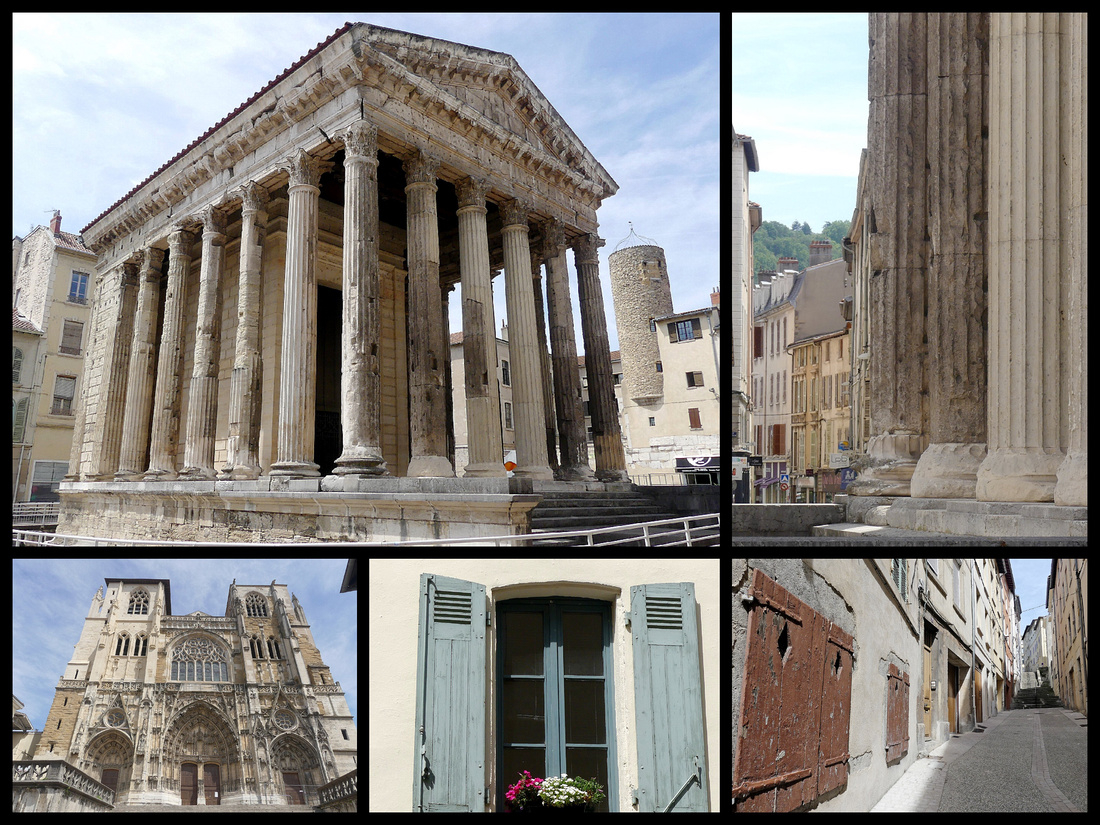

There’s also a theater but it was ‘closed’ for performances so I couldn’t even look at it. But free and always open is the Jardin Archeologique de Cybele, a public garden littered with Roman fragments including a large wall, various terraces and the foundation of several houses, and two large perpendicular archways that would have opened onto the forum.
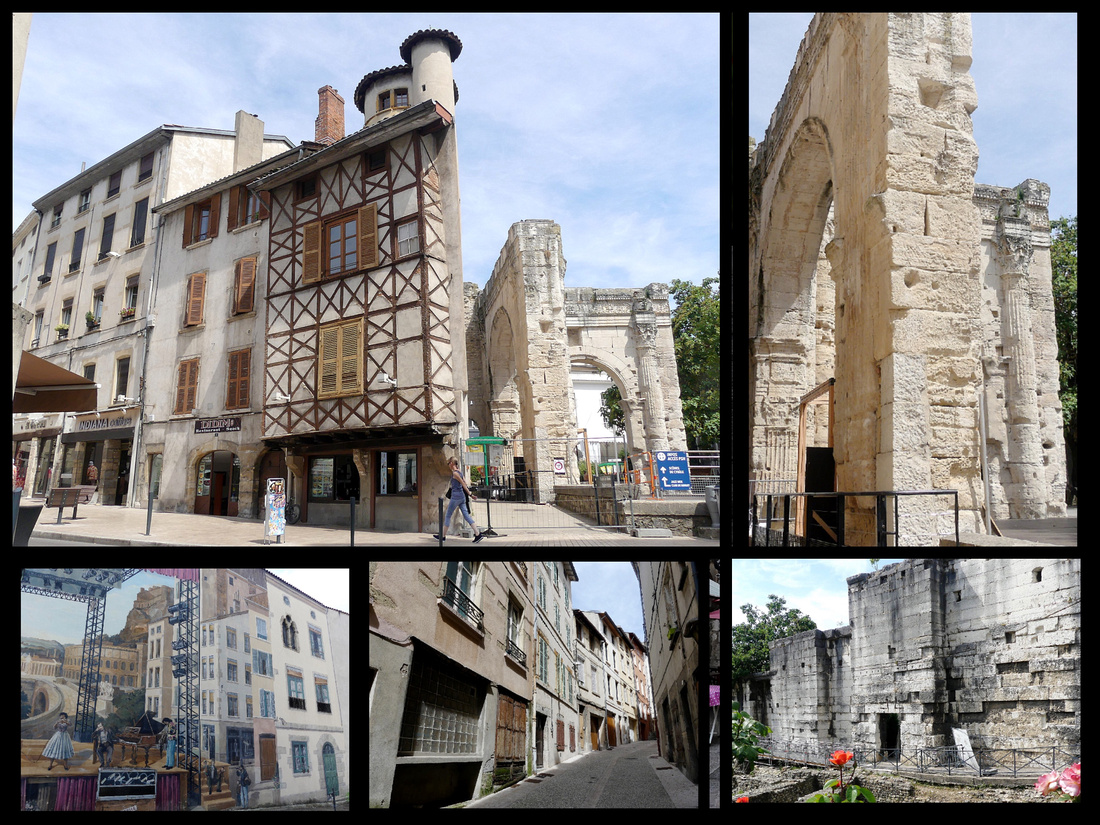

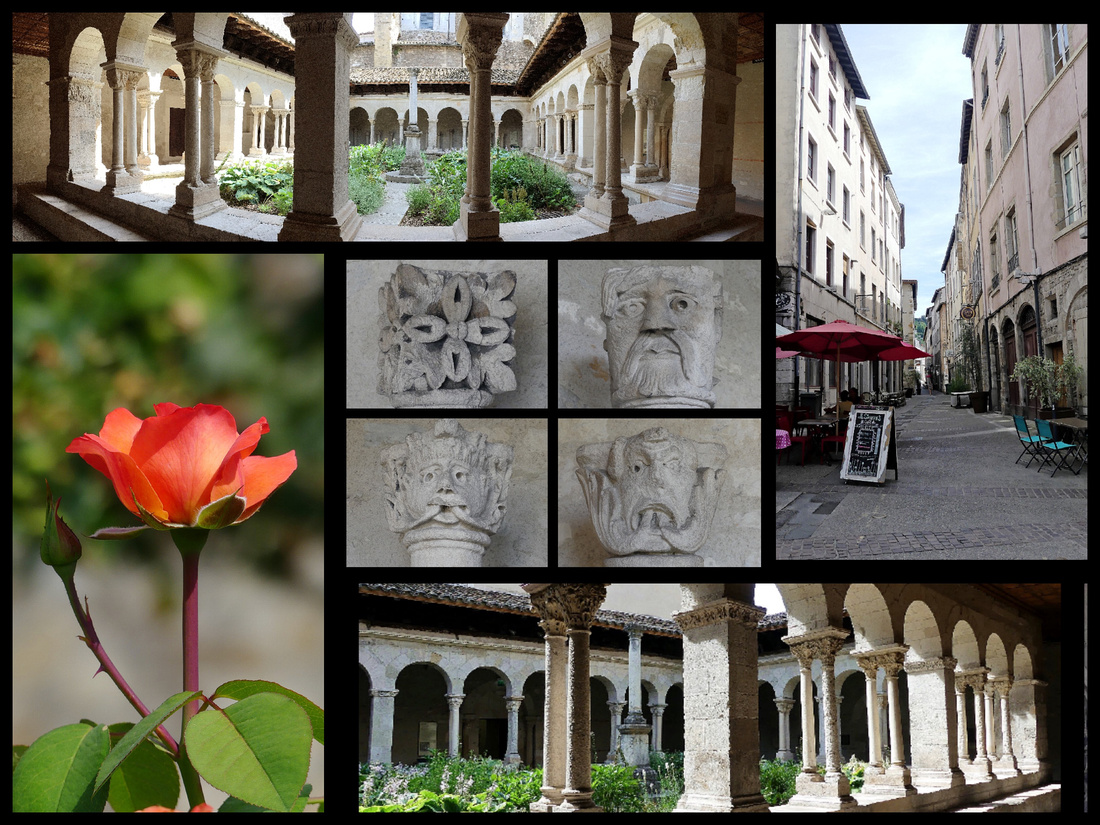
 There’s also a couple of impressive churches, Cathedrale St Maurice is huge with intricate stonework on the front, and St Andres le Bas has a very pretty cloister with some well preserved stone carvings. Vienne the city is kind of a dump, not horrible but if it weren’t for the roman ruins it would not be on the tourist map at all. Two hours was plenty.
There’s also a couple of impressive churches, Cathedrale St Maurice is huge with intricate stonework on the front, and St Andres le Bas has a very pretty cloister with some well preserved stone carvings. Vienne the city is kind of a dump, not horrible but if it weren’t for the roman ruins it would not be on the tourist map at all. Two hours was plenty.
DIJON
DIJON is the most gorgeous, most French city I’ve ever seen. Perfect size – although the entire city has a population of 150,000, most of the old center is pedestrianized, a mixture of gorgeous medieval half-timbered houses and elaborate French Renaissance facades, almost every street and square is impeccable. The town has a walking tour, “The Owl’s Tour” which has brass plaques in the pavement all along it and numbered plaques in front of the most historic buildings. The TI sells a booklet with information corresponding to each number It’s called the “Owl’s Tour” because the Owl is the symbol of Dijon.
“The historic center of Dijon has been listed as a World Heritage site by UNESCO as well as the ‘climate’ that grow vines on the slopes of the Côte de Nuits and the Côte de Beaune in the Côte d’Or département, Burgundy. Burgundy wine has been produced from the High Middle-Ages and Dijon, the capital of Burgendy, was the trading centre from where the wine activity was managed. The town has kept many marks of its rich pasts in churches, palaces, townhouses and monuments.”
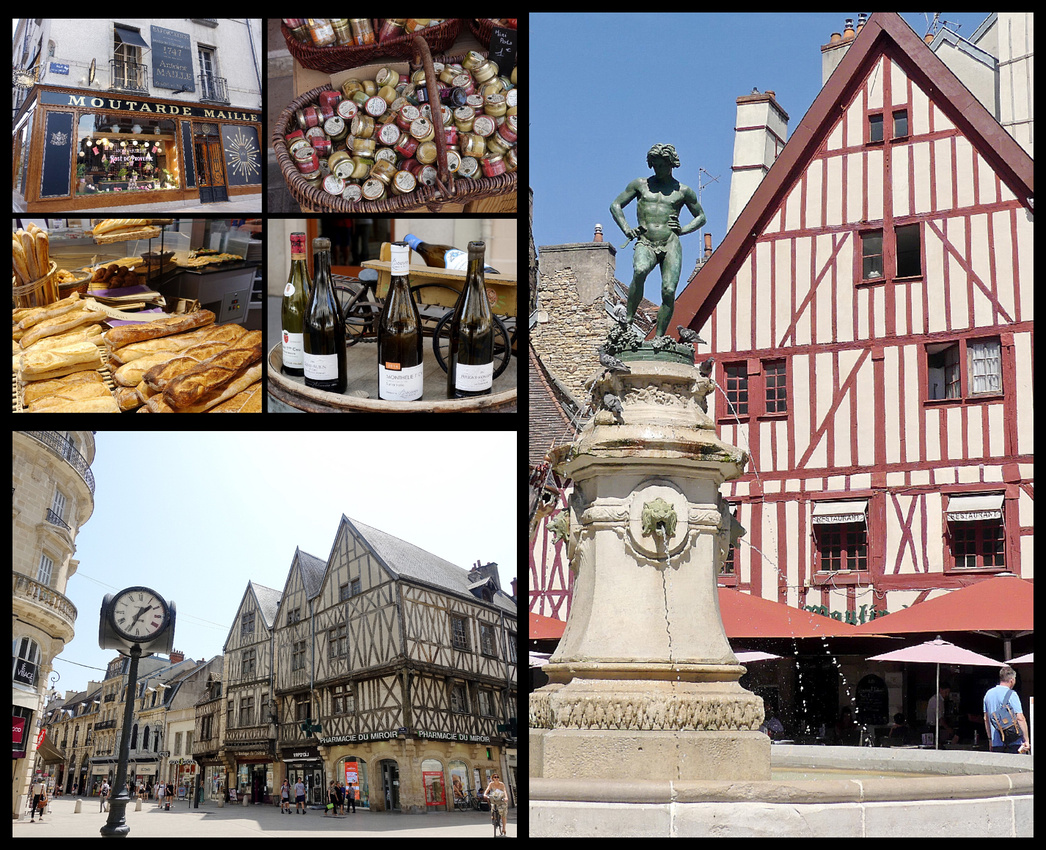

Above top left: products of Dijon including burgundy wine, bread, and of course Dijon mustard; right: the wine fountain in Place Francois Rude; lower left: the main pedestrianized street through old Dijon, Rue de la Liberte
The most interesting square is Place Francois Rude, in the center of the pedestrian area, a strangely shaped charming square, with timber-framed houses, an old fashioned carousel, and a fountain with the figure of a wine-grower treading the grapes. The fountain only provides water, except during wine festivals when, at least historically, actual wine flowed.
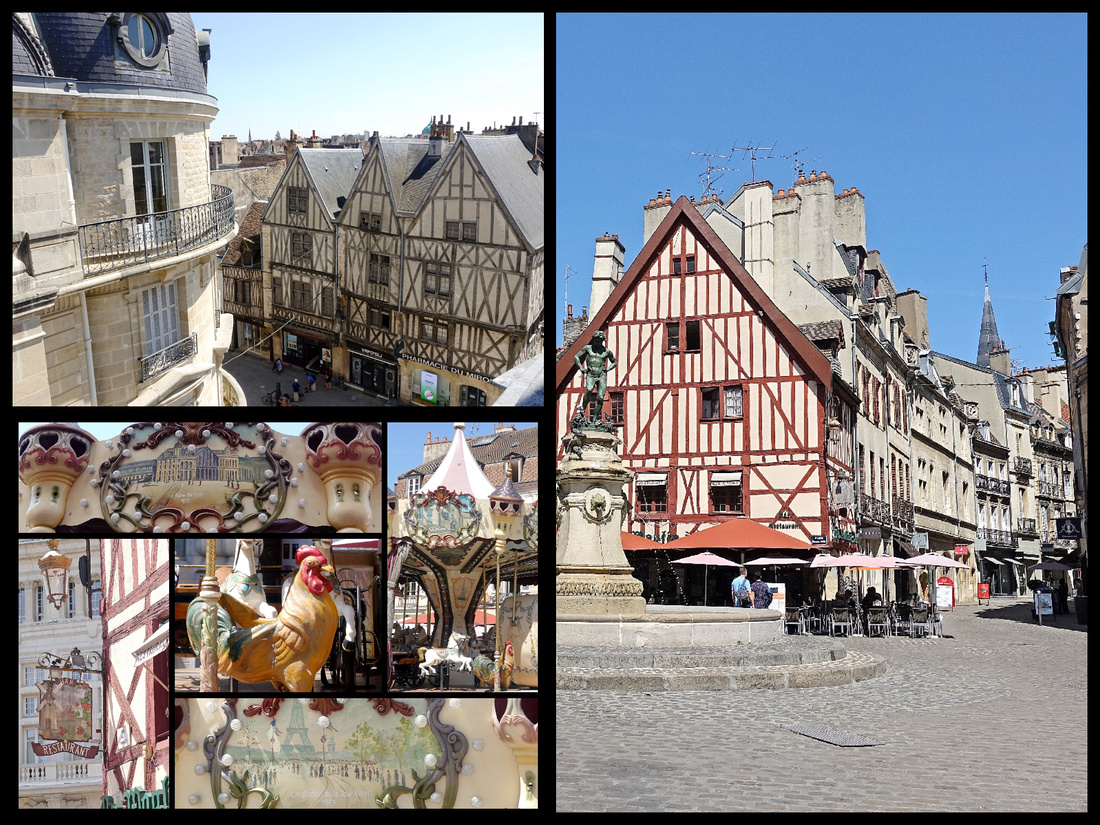

Above top left: view from my hotel room; Right: Place Francois Rude with Rue des Forges leading off it; lower left: the carousel on Place Francois Rude
Leading off Place Francois Rude is Rue des Forges, a narrow street with several exquisite houses.
#40 Hotel Aubriot, 13th Century (originally the money exchange)
#38 Maison Maillard (Milsand), 1560, remarkable Renaissance façade, heavily decorated
#34 Hotel Chambellan, 1490, Gothic flamboyance on the courtyard side
#56 Hotel Morel-Sauvergrain, 15th Century
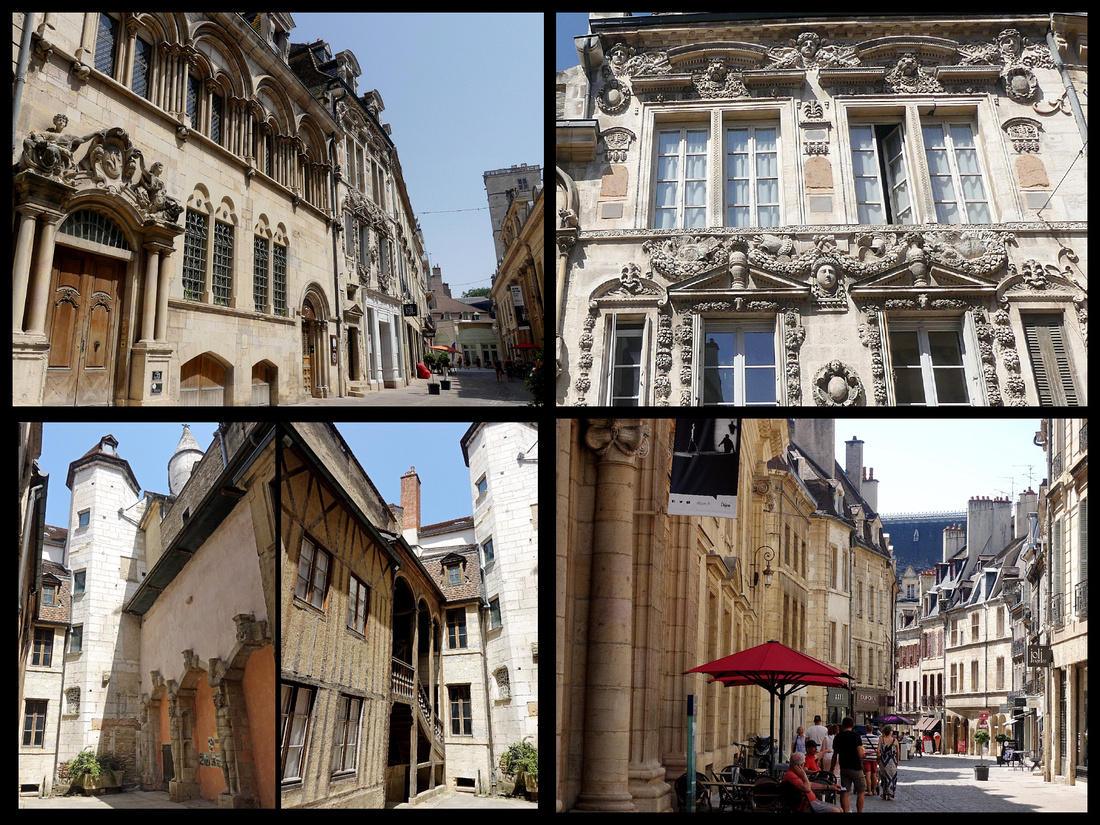
 Above top left: Hotel Aubriot; top right: Maison Maillard; Lower left: courtyard of Hotel Chambellan; Lower right: Rue des Forges
Above top left: Hotel Aubriot; top right: Maison Maillard; Lower left: courtyard of Hotel Chambellan; Lower right: Rue des Forges
The end of Rue des Forges opens up to another square, Place Notre Dame, on one side of which is the back of the Palais des Duc, housing the TI office, and the other side of which is the Cathedral Notre Dame. The original Gothic structure of Notre Dame dates to the 13th Century, with an unusual façade decorated with three large arches and rows of false gargoyles and crowned by “Jacquemart”, the bell which was taken from Flanders after the war of 1383. Originally it was just the male figure, the female was added in 1651 and the male child in 1714 and finally the female child in 1884. Only a few of the many gargoyles are original. Around the back of the church is The Owl of Notre Dame de Dijon, the city’s symbol and unofficial talisman, a stone carving on an otherwise unremarkable corner of the church, and if you touch him with your left hand and make a wish, your wish will come true. Not original to the church, the owl was added—no one knows why or by whom—during construction of a more modern chapel (and by European church standards, “modern” means early 16th Century). Here the narrow pedestrian street is called Rue de la Chouette, “Owl Street.”
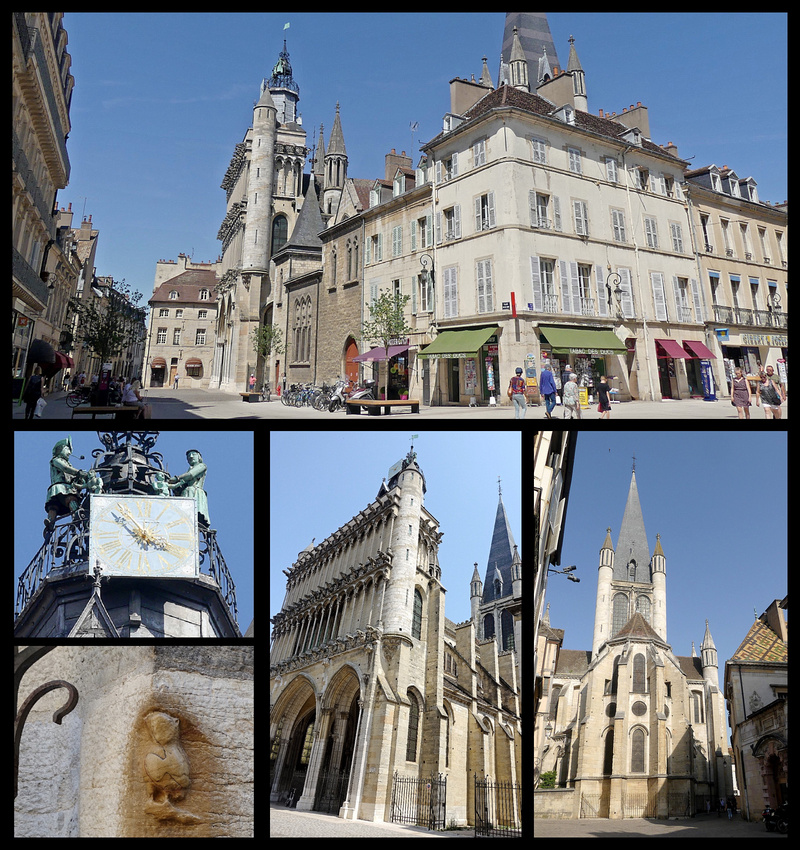

Architecturally suggestive of the city’s former glories, are the lavish townhouses of the rich burghers. These abound in the streets behind the duke’s palace, most notably on rue de la Chouette. Some are half-timbered, with storeys projecting over the street, others are in more formal and imposing Renaissance stone. Around the side corner of Notre Dame (just past the owl) is Maison Milliere – 1483 merchant house with original medieval appearance: a street stall on ground level and family living quarters above. The cat and the owl on the roof are 20th Century. Beyond that, L’Hotel de Vogue is a 17th Century town house (courtyard and garden of which were used in the film “Cyrano de Bergerac” with Gerard Depardieu).


Above top left photos: Maison Milliere; Lower center and right: L’Hotel de Vogue
Around the corner is Rue Verrerie which is the antiques dealers quarter, typical of the middle ages with well-aligned houses, corbelled wooden-beamed walls and arcades.


At the opposite end of Rue Verrerie is Place des Ducs-de-Bourgogne, a charming little shady square with a large fountain just behind the Palais des Ducs with the Tour Philippe le Bon (15th century, 316 steps). A couple of different passages lead through the Palais to Place de la Liberation.
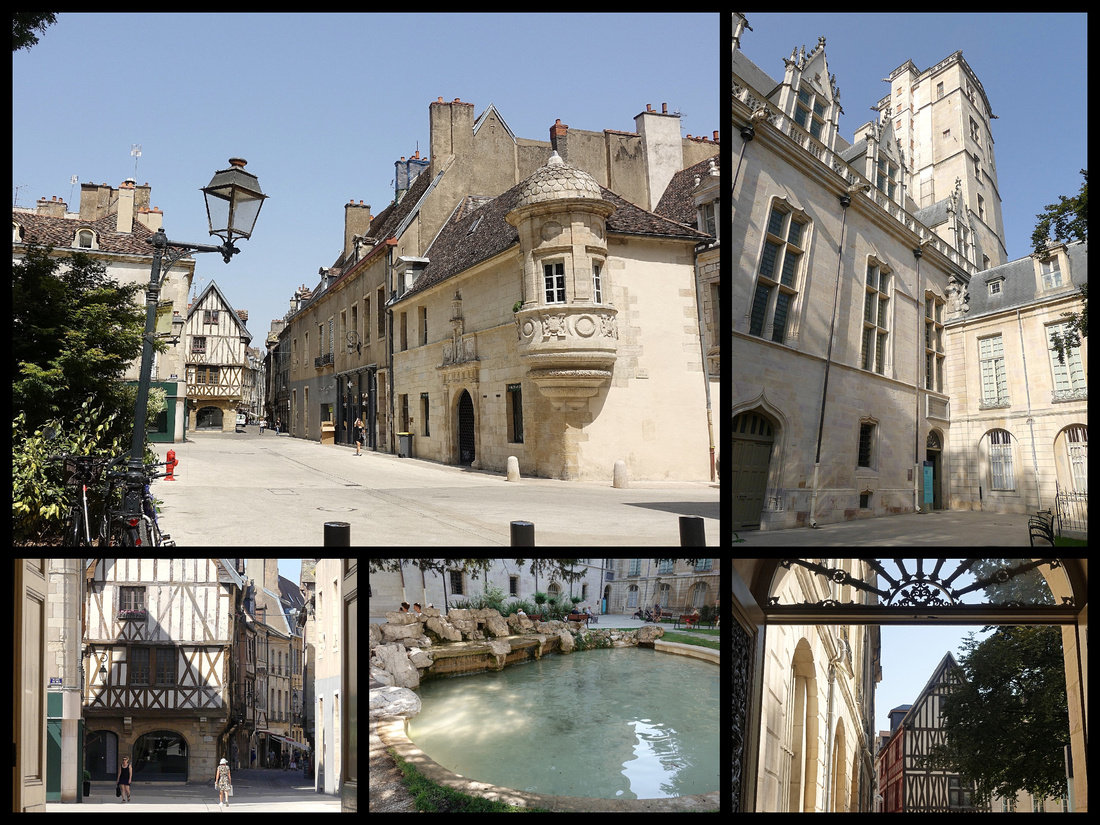

Palais des Duc et Des Etats de Bourgogne was originally built in 1366, reconstructed in the 17th Century by Mansart, the Versailles architect, finished in the 19th Century. Capped with an elaborate tile roof, the complex is arranged around a trio of courtyards. The oldest section is the Ancien Palais des Ducs de Bourgogne, erected in the 14th and 15th Centuries. The newer section is the Palais des Etats de Bourgogne, constructed in the 17th and 18th Centuries for the Burgundian parliament. The Chapelle des Elus (free access via the tourist office) dates from 1738. Today the palace is la mairie (the town hall); all of its newer sections and much of its older sections are reserved for the municipal government and not open to the public. Tour de Bar 1365, is the oldest part, facing the tower is the old palace kitchen, with six grand fireplaces. It was designed according to the model of a medieval dungeon. The east wing houses the Musee des Beaux Arts.
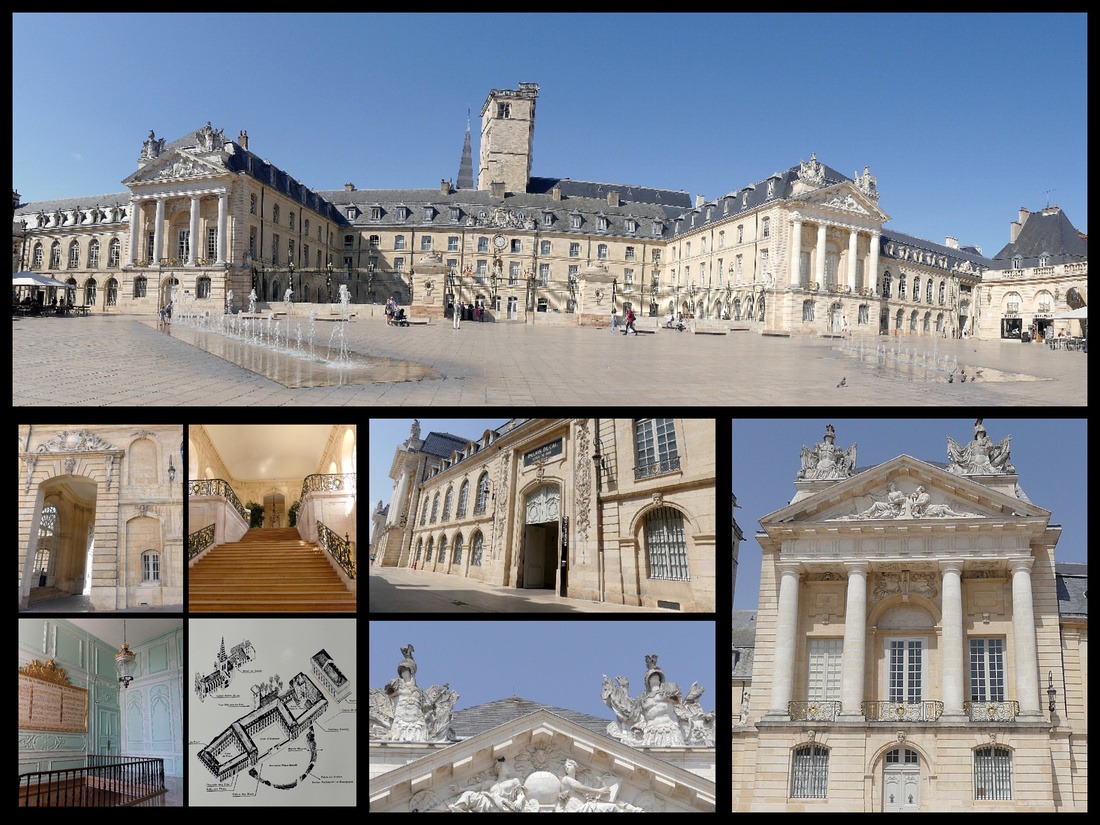

Above top: Place de la Liberation Lower photos: Palais des Duc
Place de la Liberation is the semi circular grand square designed in 1685 by Mansart to receive the equestrian statue of King Louis the XIV; today features several pavement fountains that are lit in bright colors at dark. The statue was melted down to make canons for the revolutionaries in 1792.


Place du Theatre – The theater is Neo-Classical, 19th Century. Across the street is La Nef, a former abbey church of St-Etienne (now a cultural center), and down the street is Eglise St-Michel which began as Gothic but whose façade is Italian Renaissance.
Palais de Justice – designed for the old Burgundy Parliament in the 16th Century

 Above left: Theater; Top center: Palais de Justice; Top right: back of La Nef ; Middle right: La Nef in the foreground, St Michael in the background
Above left: Theater; Top center: Palais de Justice; Top right: back of La Nef ; Middle right: La Nef in the foreground, St Michael in the background


Saint-Benigne – The second major church in Dijon besides Notre Dame, Saint Benigne is Burgundian Gothic with a flamboyant polychrome roof and has the highest bell tower in Dijon. Inside it is a fairly typical, average sized catholic church, made nicer by the sun coming through the stained glass and music (recorded, not live, but lovely female voices). The highlight though, and the only part that charges a fee (€2), is the circular 6th century crypt.
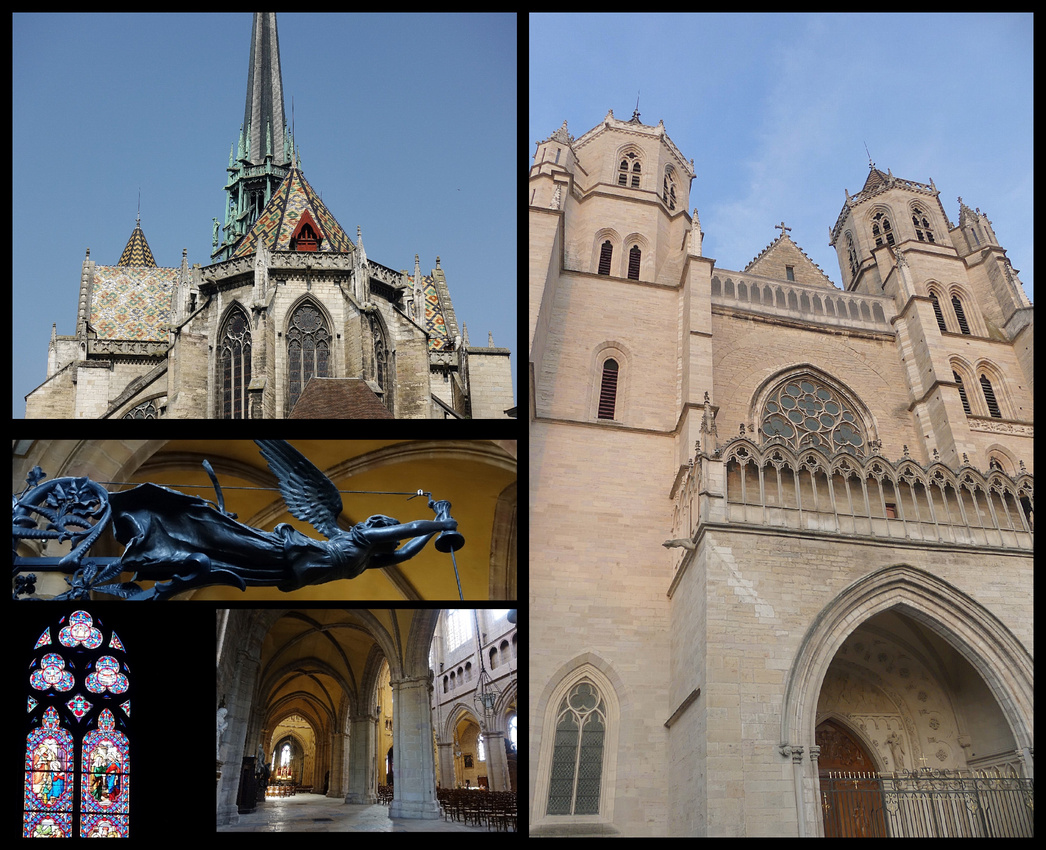

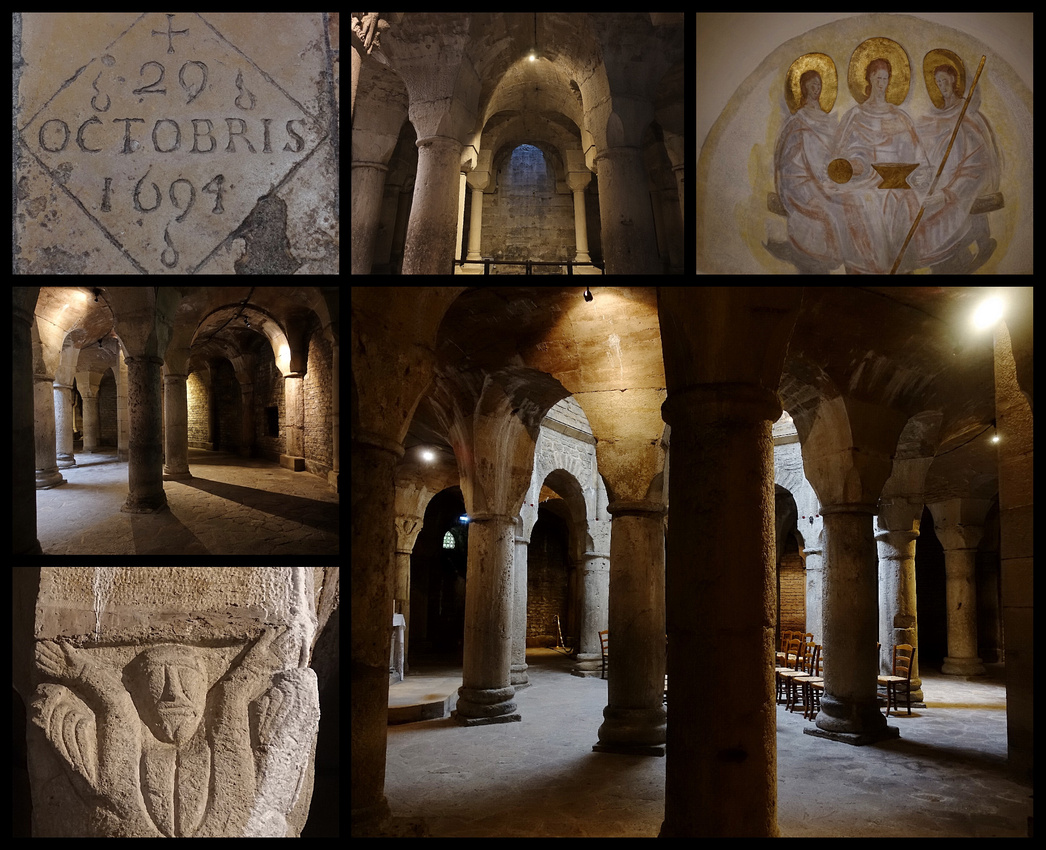

In the abbey next door is the Archaeology Museum. The lowest level has Roman statuary and other carvings, none in particularly great condition but for a free museum of this size they were quite good. The next level is full of graceful columns and arches, the top level had displays on evolution.
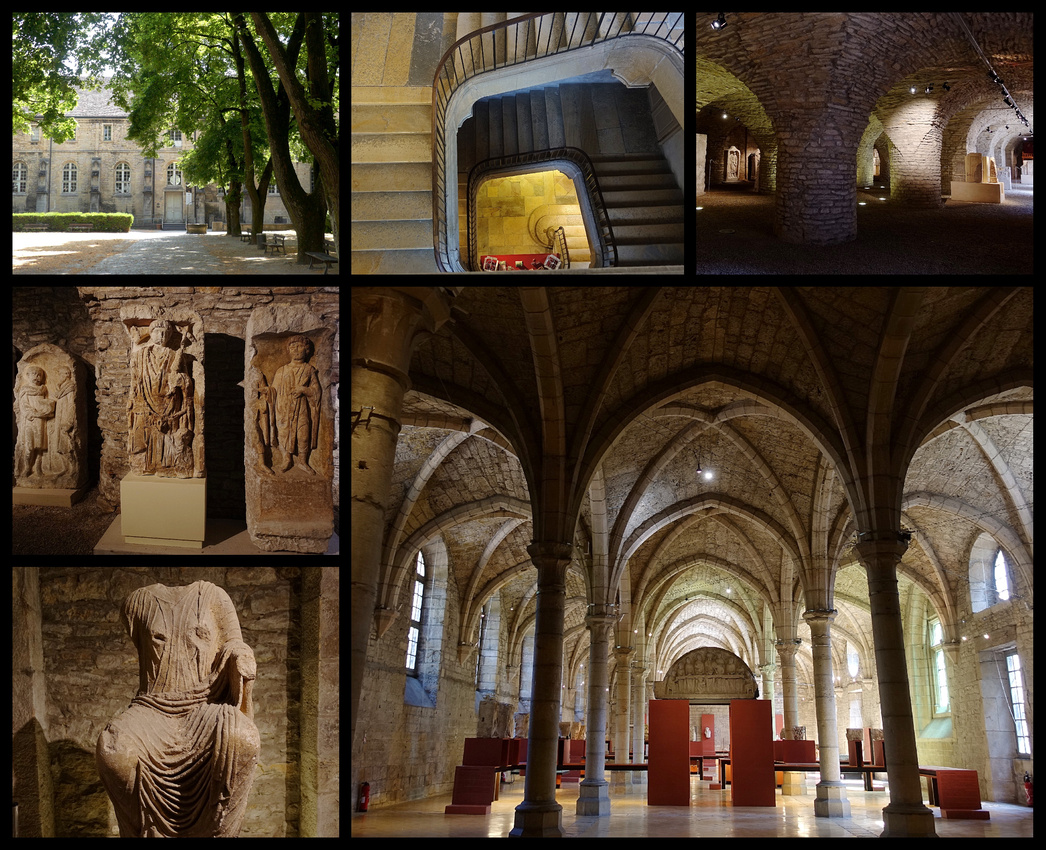

Nearby the Couvent des Bernadines houses the Musee de la View Bourguignonne (Museum of Burguandian Life) a collection of rural ethnography costumes, furniture, etc depicting daily life from the 18th-20th centuries. There are also recreations of 11 shops that used to be in Dijon including a pharmacy, grocery, hat shop, clock maker, etc. The cloister of the convent is austere but nice.




Musee des Beaux Arts – also free – pretty decent art museum for a city this size. Mostly French artists I’ve never heard of, none of the ‘major’ works but a nice variety of, some of which I liked and it is housed in one of the best preserved medieval palaces in France. Some of the rooms have been done over and look like generic museum rooms, but a few are preserved as palace rooms. There are middle ages and Renaissance works plus contemporary pieces all kind of jumbled together which was actually more interesting than confusing. The tombs are the most well known.
A short walk from the Dijon Gare is the Jardin Darcy the town's first pubic garden . The garden features a lovely pool of blue-green water and is guarded by a "white bear" sculpture. Across the street is the Hotel de la Cloche, from the 15th century. And across the square from that is, Porte Guillaume, an 18th century triumphal arch, originally part of the town ramparts which were torn down in the 19th century leaving it standing alone in the middle of the square. Rue de la Liberte, the major pedestrian shopping street through the old city begins here.
One block north of Rue de la Liberte, Place Grangier is the site of the Hotel des Postes and an Art Nouveau building – totally different architectural styles designed at the same time by the same architect. Just past this is the Dijon Market, built in 1873. Athough housed in an impressive glass and iron building, unfortunately as European markets go, it was a dud.
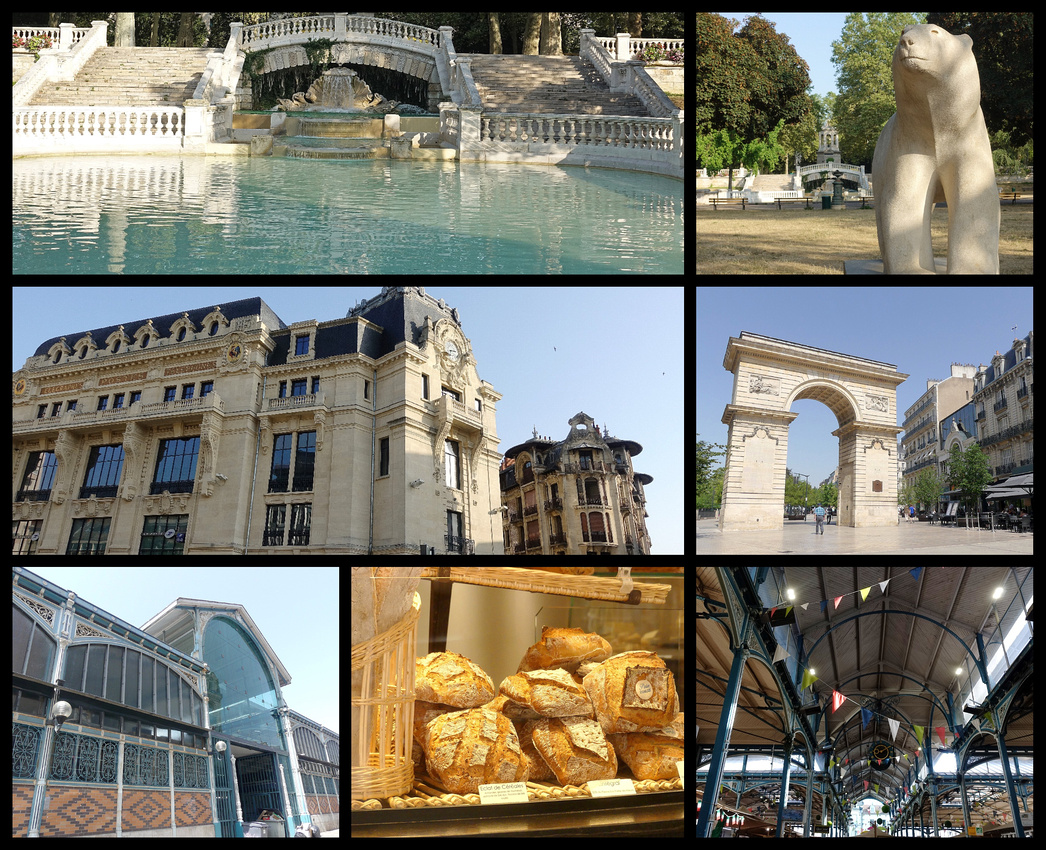
 Above top: Jardin Darcy; Middle left: Hotel des Postes with the art nouveau building beside it; Middle right: Port Guillaume Lower: Dijon Market
Above top: Jardin Darcy; Middle left: Hotel des Postes with the art nouveau building beside it; Middle right: Port Guillaume Lower: Dijon Market
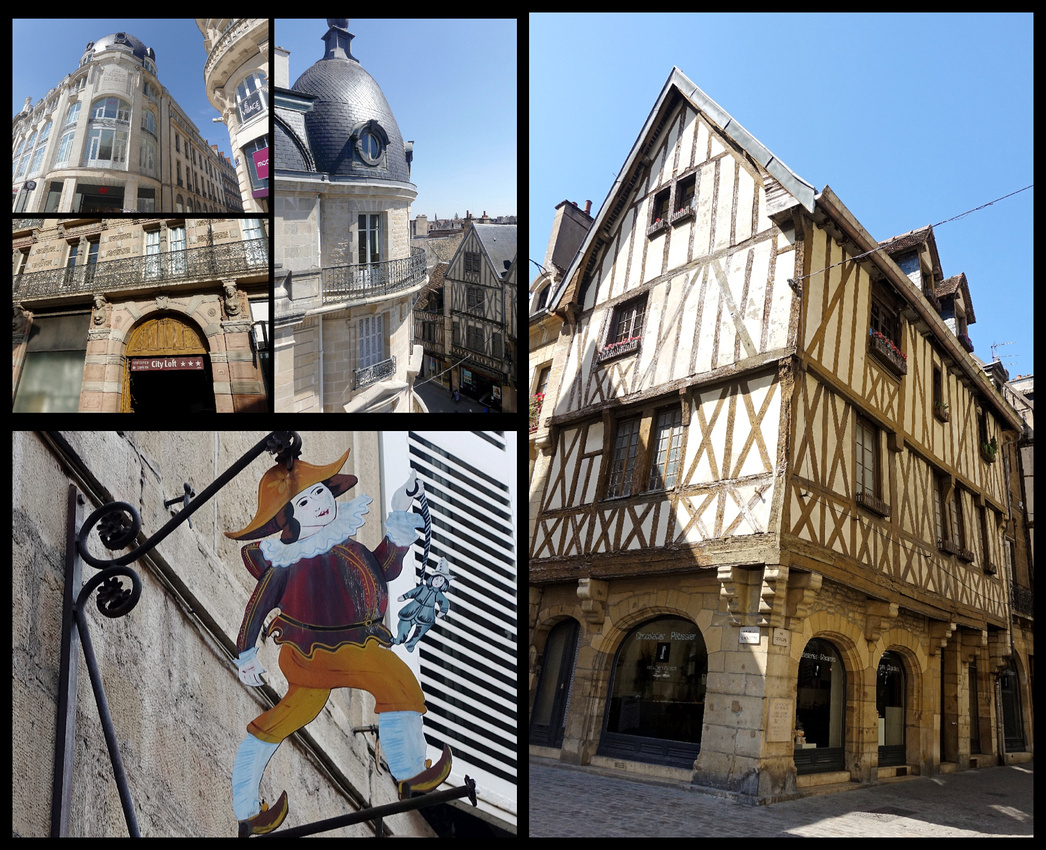

Above left: City Loft Apartments entrance and view from my room.
Dijon is a beautiful little city, just large enough that you don't get bored in an hour, small enough to know your way around the center easily enough. Even with doing the Owl walking tour, visiting three museums, two churches and a crypt two days was plenty. It would make a wonderful place to base to do day trips to the surrounding region.
I stayed at the "City Loft Apartments", which for €71 night/single was one of the best bargains of the trip. The room was gigantic, with a kitchenette, right in the center of the old town (ten minute walk from the train station) with a fabulous view.
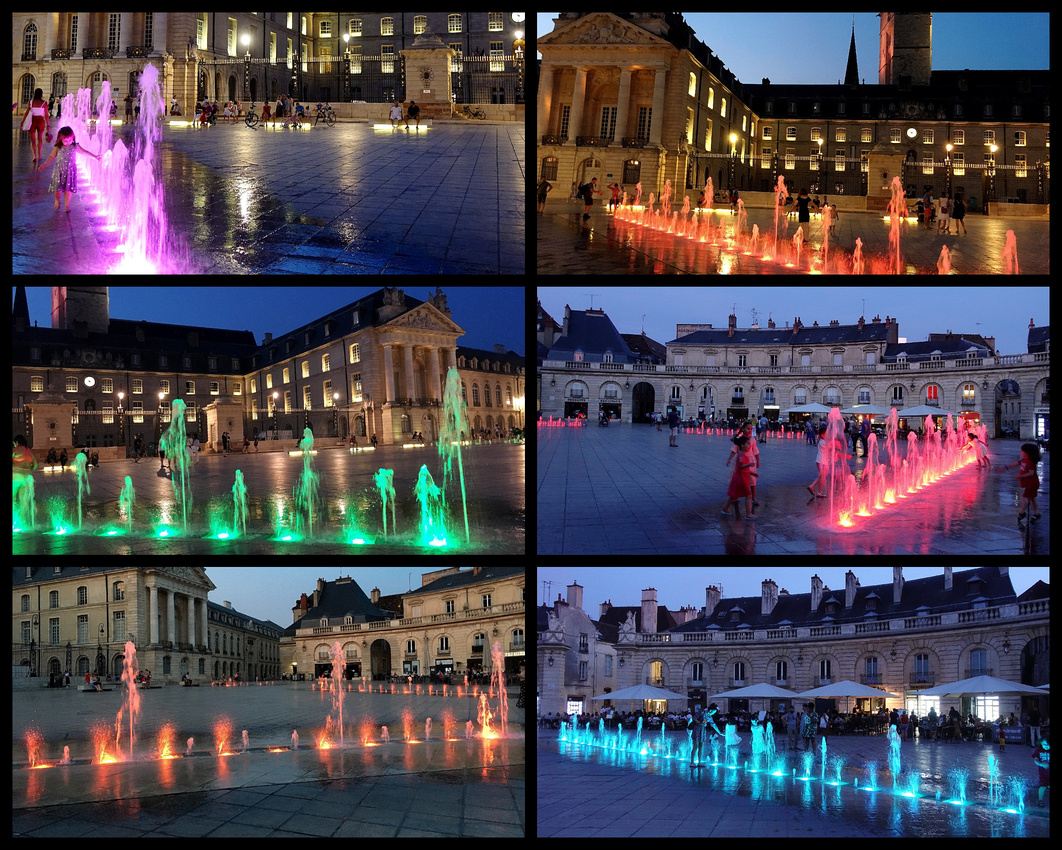

Place de la Liberation with it's multiple pavement fountains was lit with alternating colors in the evening, children were playing in the fountains (the high temperature while I was in Dijon was 102 F), the square is surrounded by restaurants with outside seating and was a lovely place to be in evening watching the sky turn deep blue and the lights come on the magnificent buildings turning them golden.
Comments
I even noticed the little angel on the wall of my back alley (rue des Bons Enfants) and where my main entrance is (rue Rameau right in front of the Dukes Palace).
Next time don't forget to visit our newly renovated Fine Arts Museum where you can almost spend a full day there. Bravo !